Robotic Sensors Market Size
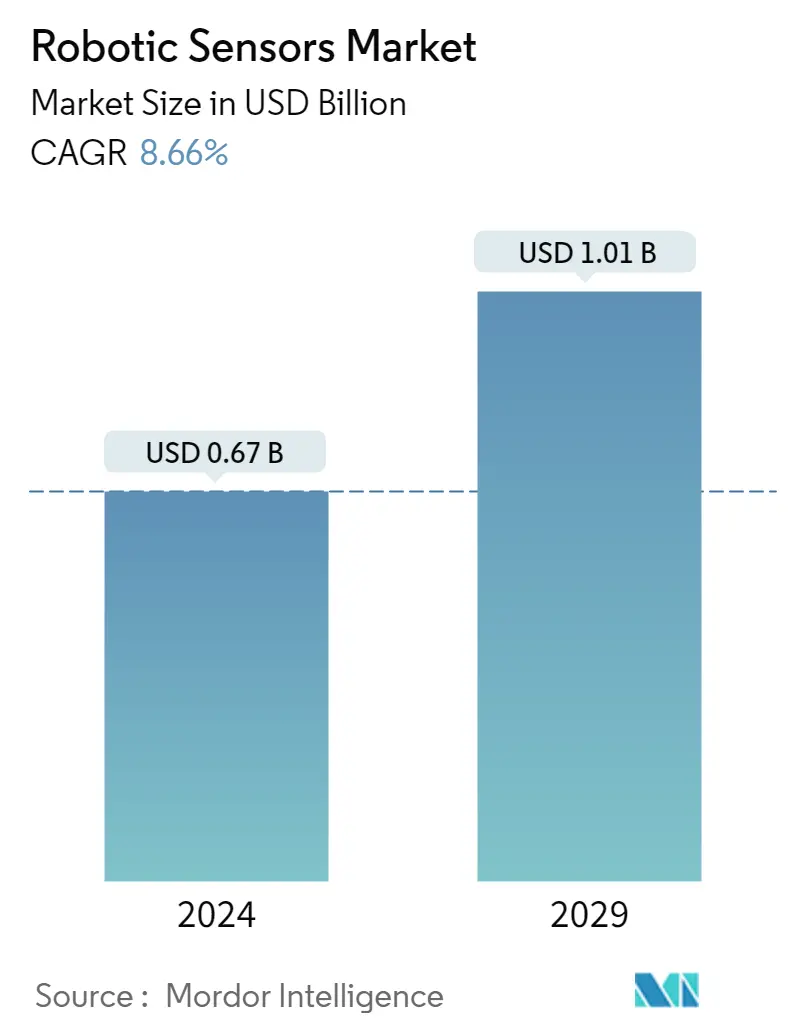
| Study Period | 2019 - 2029 |
| Market Size (2024) | USD 0.67 Billion |
| Market Size (2029) | USD 1.01 Billion |
| CAGR (2024 - 2029) | 8.66 % |
| Fastest Growing Market | Asia Pacific |
| Largest Market | Asia Pacific |
Major Players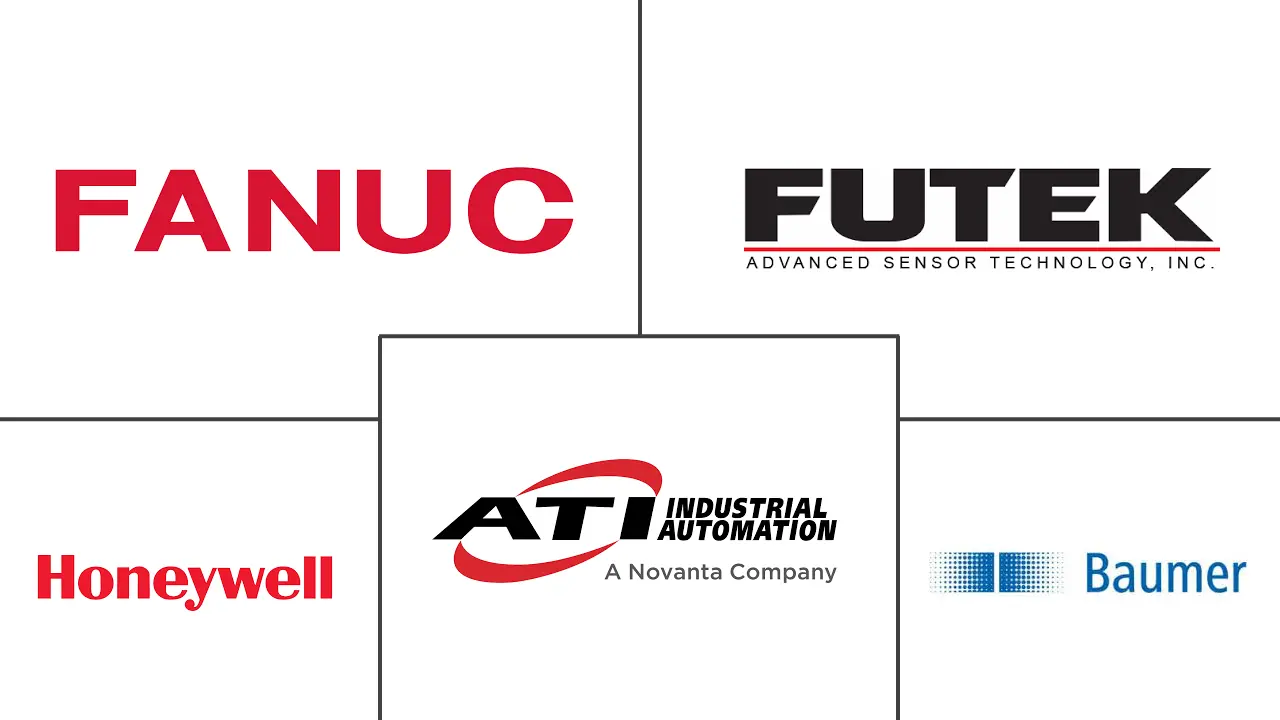
*Disclaimer: Major Players sorted in no particular order |
Robotic Sensors Market Analysis
The Robotic Sensors Market size is estimated at USD 0.67 billion in 2024, and is expected to reach USD 1.01 billion by 2029, growing at a CAGR of 8.66% during the forecast period (2024-2029).
The market studied is anticipated to grow due to the adoption of Industry 4.0 and IIoT solutions across the various end-user industries. Also, government investments in research and development and a growing emphasis on sustainability further drive the demand of the market studied. In addition, various players in the examined market are focusing on high-growth sectors such as automotive and manufacturing to keep their business growing in the market studied.
- Many factors, including rapid technological advancements in automation, artificial intelligence, energy storage, engineering, and machine learning, drive the growth of the market. The skill shortage is the primary factor impacting the increasing adoption of robots. Coupled with the lack of labor, the rising earnings of the workforce are also influencing the demand dynamics of robots across geographies. Moreover, the workforce needs to be trained frequently to adapt to new technologies. As a result, it drives organizations to adopt robotic systems, encouraging the market vendors to innovate on the components of the systems.
- Furthermore, manufacturing in developing and underdeveloped nations is currently undergoing a constant robotic evolution. However, workers are expected to continue to enter the service business, lowering wages and resulting in job growth and pay stagnation in the service sector rather than widespread unemployment, at least in the near and medium term. The prospect of digital technologies to automate routine tasks and replace human labor can sometimes appear like an existential threat to manufacturing in developing countries. Such predictions tend to be based on technical feasibility. However, the automation of jobs also depends on economic and institutional feasibility, and these factors can outweigh the technical aspects in underdeveloped countries.
- The growing adoption of robots for automation is expected to drive the robotic sensors market. Robots are machines programmed to perform tasks and are equipped with various sensors, actuators, and control systems. These sensors enable robots to interact with their environment and perform tasks effectively. In October 2022, according to robotics research published by the International Federation of Robotics, the food and beverage industry in the United States deployed 25% more robots last year, intending to reach 3,402 units by 2021. The higher level of hygiene provided by robotics, according to IFR, may have contributed to the surge in the aftermath of the COVID-19 pandemic.
- However, a high installation cost is the primary factor challenging the market's growth. In addition, the requirement of a highly skilled workforce to operate and maintain the automation or robotics infrastructure further adds to the overall cost, restraining mass adoption, especially in small and medium-scale industries.
- With the outbreak of the COVID-19 pandemic, various pharmaceutical manufacturers increasingly felt the substantial need to react promptly to the need for hospitals and pharmacies. The COVID-19 pandemic induced restrictions that forced the companies to operate with limited labor onboard, subsequently affecting the operational capacities of the companies across the world. Several enterprises started to invest in automation technologies to overcome this labor shortage and reduce their dependence on human labor. The increasing demand for robotic systems in the pharmaceutical industry propels the need for robotic sensors, positively influencing the market studied.
Robotic Sensors Market Trends
Manufacturing to be the Largest End-user Industry
- The emergence of the Industrial Internet of Things and collaborative robots are expected to drive the robotic sensors market. By 2023, IoT devices are expected to make up to 50% (14.7 billion) of all networked devices, up from 33% (6.1 billion) in 2018. Such an increase in IoT devices would drive the growth of the market studied.
- With technical advancements in Industrial IoT, Augmented Reality (AR), cloud computing, and other technologies, global manufacturing organizations have assembled intelligent factories to realize automation, information, and intelligent industrial production. Industrial robots, for example, will play a vital role in this smart manufacturing transformation.
- Moreover, several factory automation and smart manufacturing initiatives devised by numerous countries are expected to offer lucrative opportunities for the growth of the robotic sensors market. For instance, the Chinese government's ambitious 'Made in China 2025' initiative, partially inspired by Germany for Industry 4.0, aims to boost the country's competitiveness in the manufacturing sector.
- The Korean government focuses on smart manufacturing and plans to have 30,000 fully automated manufacturing companies by 2025. The government aims to achieve this by incorporating the latest automation, data exchange, and IoT technologies.
- According to the Japan Robot Association, 2022, the orders for industrial robots from Japanese manufacturers hit a record JPY 955.8 billion (USD 7.35 billion) in 2022, up by 1.6% from the previous year. Strong demand for production line automation due to the shift to electric vehicles and global labor shortage underpinned the growth in orders.
- The rapid and continuous introduction of several new sensor technologies is prominent in developing next-generation industrial robots. New sensor technologies are enabling robots to see and sense their surroundings accurately, perform tasks precisely, and avoid obstacles, including people. Similarly, the integration of unique force and tactile sensors is facilitating robots to have improved touch and feel capabilities that allow them to perform more precise tasks and operate more safely.
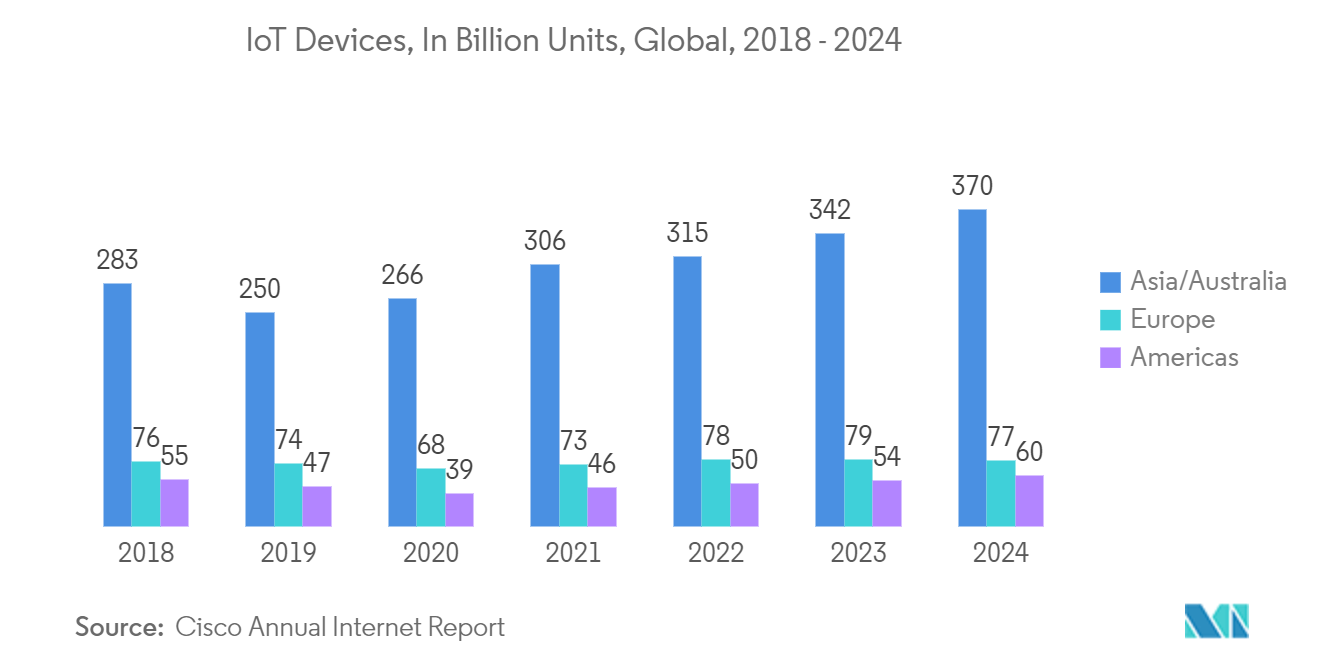
Asia Pacific to Dominate the Market
- Asia-Pacific is anticipated to record the highest growth rate during the forecast period, pertaining to the noteworthy installation of industrial robots in several countries, including China, Japan, India, South Korea, and Taiwan. China is dominating the regional adoption rate of sensors for robotic applications due to the massive deployment in the country's dominating automotive and semiconductor manufacturing industries.
- China is a manufacturing leader and has a strong consumer base for electronics and related components, which is a major factor contributing to the robotic sensors market. The country has a significant manufacturing base in automotive, electronics, aerospace and defense, food and beverage, and other industries, which is expected to boost the market's growth further.
- The growing government aid in the improvement of the advanced manufacturing sector is set to positively impact the market's growth. The government of China launched "Made in China 2025", a state-led industrial policy that seeks to make China dominant in global high-tech manufacturing.
- Furthermore, China's Ministry of Industry and Information Technology, the National Development and Reform Commission, the Ministry of Science and Technology, and 12 other agencies released "The 14th Five-Year Development Plan for the Robotics Industry" in December 2021. This is China's second five-year growth plan for the robotics industry, and it serves a critical role in facilitating and encouraging the industry's high-quality development.
- By 2025, the country aims to exceed its average annual growth rate of operating income by 20% in the robotics industry. The five-year plan set out objectives to expand the breadth and depth of robotic applications to continue to increase the number of robots in the country. It also aims to promote a more stable and robust supply chain and to standardize the industry better. As robotics involve various types of sensors in touch, proximity detection, and so on, the sector's growth as a whole is set to boost the market's growth.
- As the automotive, electronics, and manufacturing sectors are also developing at a significant growth rate in other economies such as South Korea, Japan, and India, there is massive potential for growth in this regional market. The regional government is also one of the major factors in the development of sensors in the robotics market.
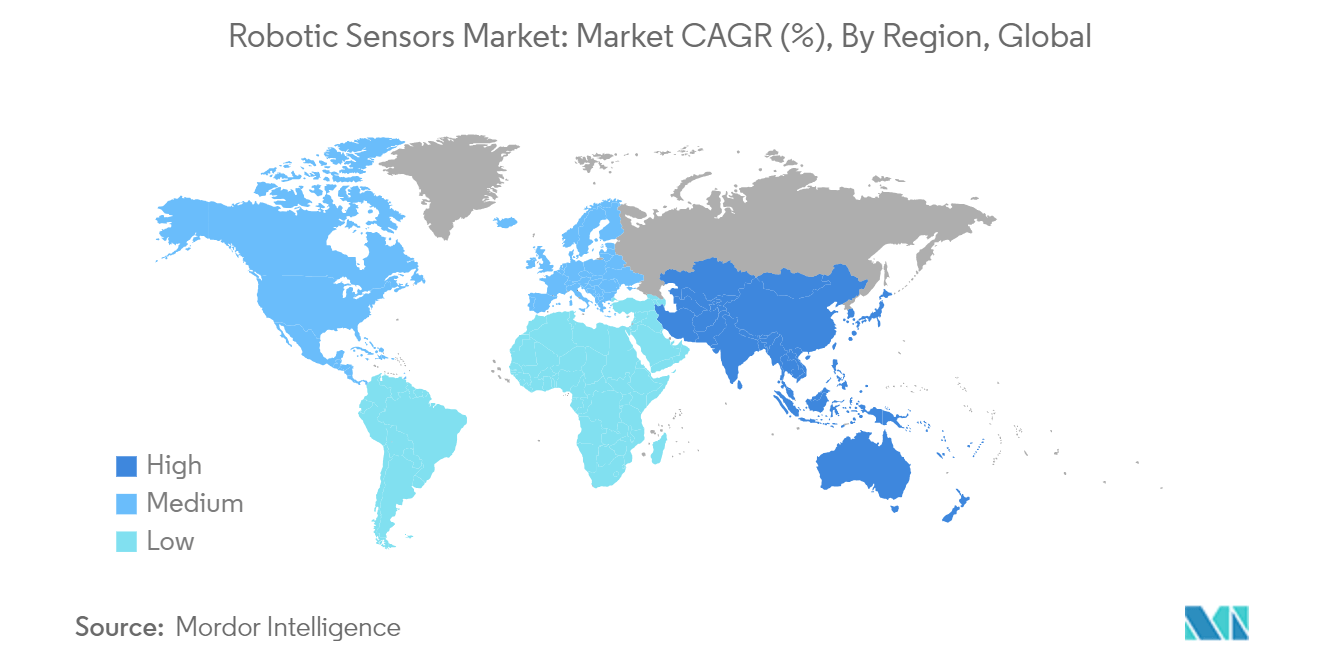
Robotic Sensors Industry Overview
The robotic sensors market is fragmented and consists of several global as well as regional players, including Honeywell International Inc., FUTEK Advanced Sensor Technology Inc., FANUC Corporation, Baumer Group, and ATI Industrial Automation (Novanta Inc.). These players with a competitive share in the market are focusing on expanding their customer base across global regions. These companies are leveraging strategic collaborative initiatives to increase their market share and regional presence.
- October 2023 - Baumer launched a new sensor class for easy positioning and inspection. By introducing the OX sensor series, Baumer enables quality control and positioning solutions with ease. With profile analysis in the OX series, previously challenging positioning and inspection tasks in assembly and handling can now be solved more economically with smart 2D profile sensors.
- August 2023 - ATI Industrial Automation announced the integration of its F/T sensors with FANUC robots and FANUC’s Force Control Software. The integration opens new opportunities for advanced automation and precise control in robotic applications.
Robotic Sensors Market Leaders
-
ATI Industrial Automation (Novanta Inc.)
-
Baumer Group
-
FANUC Corporation
-
FUTEK Advanced Sensor Technology, Inc.
-
Honeywell International Inc.
*Disclaimer: Major Players sorted in no particular order
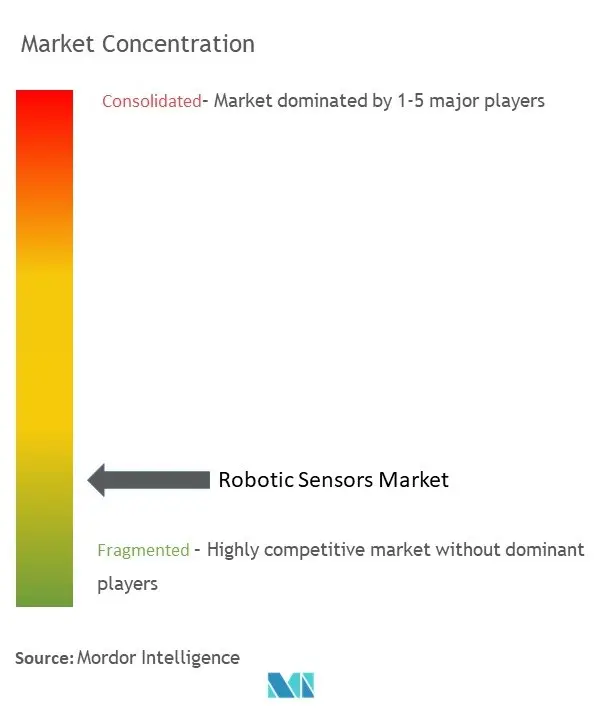
Robotic Sensors Market News
- October 2023 - Nvidia teamed with Segway-Ninebot to launch a robotics development platform to accelerate the development and deployment of Autonomous Mobile Robots. The Nova Carter AMR gets its mobility from Segway's RMP Lite 220 chassis and is powered by Nvidia's chips, algorithms, and sensors, with Segway handling its integration. It also has 360° perception due to cameras and lidar, high-performance computing modules, sensors, autonomous driving development software, and tools.
- August 2023 - ATI Industrial Automation announced that its Multi-Axis Force/Torque Sensors are compatible with FANUC's robots and Force Control Software. This collaboration opens up unique possibilities for advanced automation and precision control in robotic applications. As per the ATI, the integration of its Multi-Axis Force/Torque Sensors with FANUC's hardware and software is expected to allow users to achieve greater levels of accuracy, flexibility, and responsiveness. Integrators and manufacturers can take advantage of the enhanced sensing capabilities.
Robotic Sensors Market Report - Table of Contents
1. INTRODUCTION
- 1.1 Study Assumptions and Market Definition
- 1.2 Scope of the Study
2. RESEARCH METHODOLOGY
3. EXECUTIVE SUMMARY
4. MARKET INSIGHTS
- 4.1 Market Overview
- 4.2 Industry Value Chain Analysis
-
4.3 Industry Attractiveness - Porter's Five Forces Analysis
- 4.3.1 Bargaining Power of Suppliers
- 4.3.2 Bargaining Power of Buyers
- 4.3.3 Threat of New Entrants
- 4.3.4 Threat of Substitutes
- 4.3.5 Degree of Competition
- 4.4 An Assessment of the Impact of Macroeconomic Factors and COVID-19 on the Market
5. MARKET DYNAMICS
-
5.1 Market Drivers
- 5.1.1 Surge in Demand for Industrial Robotics
- 5.1.2 Increased Adoption of Robots in Logistics and Transportation Application
- 5.1.3 Technological Advancements in Collaborative Robots (Cobots)
-
5.2 Market Restraints
- 5.2.1 Slow Adoption Rate in Underdeveloped Regions
6. MARKET SEGMENTATION
-
6.1 By Type
- 6.1.1 Force and Torque Sensor
- 6.1.2 Temperature Sensor
- 6.1.3 Pressure Sensor
- 6.1.4 Position Sensor
- 6.1.5 Proximity Sensor
- 6.1.6 Vision Sensor
- 6.1.7 Other Type of Sensors
-
6.2 By End User
- 6.2.1 Manufacturing
- 6.2.2 Automotive
- 6.2.3 Process and Packaging
- 6.2.4 Logistics
- 6.2.5 Other End Users
-
6.3 By Geography
- 6.3.1 North America
- 6.3.2 Europe
- 6.3.3 Asia-Pacific
- 6.3.4 Rest of the World
7. COMPETITIVE LANDSCAPE
-
7.1 Company Profiles
- 7.1.1 ATI Industrial Automation (Novanta Inc.)
- 7.1.2 Baumer Group
- 7.1.3 FANUC Corporation
- 7.1.4 FUTEK Advanced Sensor Technology Inc.
- 7.1.5 Honeywell International Inc.
- 7.1.6 Infineon Technologies AG
- 7.1.7 OMRON Corporation
- 7.1.8 Sensata Technologies Inc.
- 7.1.9 TE Connectivity Ltd
- 7.1.10 Tekscan Inc.
- *List Not Exhaustive
8. INVESTMENT ANALYSIS
9. MARKET OPPORTUNITIES AND FUTURE TRENDS
** Subject To AvailablityRobotic Sensors Industry Segmentation
Robotic sensors are technical sensors designed for use in robotics and automation systems to measure the condition of robots and their surrounding environments. They deliver critical information to robots, enabling them to interact with the environment effectively.
The robotic sensors market is segmented by type (force and torque sensor, temperature sensor, pressure sensor, position sensor, proximity sensor, vision sensor, and other types of sensors), end user (manufacturing, automotive, process and packaging, logistics, and other end users), and geography (North America, Europe, Asia-Pacific, Latin America, and Middle East and Africa). The report offers the market size in value terms (USD) for all the above-mentioned segments.
| By Type | Force and Torque Sensor |
| Temperature Sensor | |
| Pressure Sensor | |
| Position Sensor | |
| Proximity Sensor | |
| Vision Sensor | |
| Other Type of Sensors | |
| By End User | Manufacturing |
| Automotive | |
| Process and Packaging | |
| Logistics | |
| Other End Users | |
| By Geography | North America |
| Europe | |
| Asia-Pacific | |
| Rest of the World |
Robotic Sensors Market Research FAQs
How big is the Robotic Sensors Market?
The Robotic Sensors Market size is expected to reach USD 0.67 billion in 2024 and grow at a CAGR of 8.66% to reach USD 1.01 billion by 2029.
What is the current Robotic Sensors Market size?
In 2024, the Robotic Sensors Market size is expected to reach USD 0.67 billion.
Who are the key players in Robotic Sensors Market?
ATI Industrial Automation (Novanta Inc.), Baumer Group, FANUC Corporation, FUTEK Advanced Sensor Technology, Inc. and Honeywell International Inc. are the major companies operating in the Robotic Sensors Market.
Which is the fastest growing region in Robotic Sensors Market?
Asia Pacific is estimated to grow at the highest CAGR over the forecast period (2024-2029).
Which region has the biggest share in Robotic Sensors Market?
In 2024, the Asia Pacific accounts for the largest market share in Robotic Sensors Market.
What years does this Robotic Sensors Market cover, and what was the market size in 2023?
In 2023, the Robotic Sensors Market size was estimated at USD 0.61 billion. The report covers the Robotic Sensors Market historical market size for years: 2019, 2020, 2021, 2022 and 2023. The report also forecasts the Robotic Sensors Market size for years: 2024, 2025, 2026, 2027, 2028 and 2029.
Robotic Sensors Industry Report
The Robotic Sensors Market Report provides an in-depth industry analysis, focusing on various types of sensors such as force and torque sensors, temperature sensors, pressure sensors, position sensors, proximity sensors, vision sensors, and other types of sensors. The report covers multiple end-user segments, including manufacturing, automotive, process and packaging, logistics, and other end users. The market analysis offers a comprehensive market forecast outlook, detailing the growth rate and market trends.
Industry reports indicate a significant market growth driven by advancements in technology and increasing demand across various sectors. The market segmentation by geography includes North America, Europe, Asia-Pacific, Latin America, and the Middle East and Africa, providing a detailed market overview of regional trends.
Market research highlights the market leaders and their strategies, contributing to the overall market value. The industry outlook and industry statistics provide insights into future market predictions and market review. The report also includes a sample PDF download for further industry research and a detailed report example for reference.
With a focus on market data and market segmentation, the report offers valuable industry information and industry sales figures, helping stakeholders understand the market size and market growth. The market forecast includes industry trends and market outlook, ensuring a thorough understanding of the market dynamics.
Overall, the Robotic Sensors Market Report is an essential resource for understanding the industry size, industry research, and market predictions, offering a comprehensive view of the market's potential and future developments.



